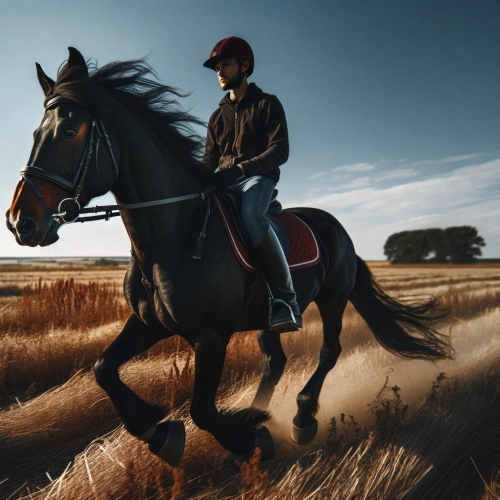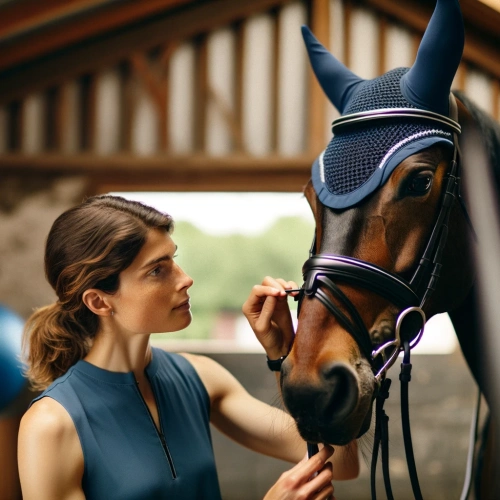The main training techniques for competition horses
Training techniques for competition horses vary depending on the discipline and specific objectives. Here are some of the main training methods:
Physical training
This stage includes regular exercises such as running, jumping, and lunging to strengthen the horse's muscles, stamina and fitness.
Mental training
Here we need to work on the horse's concentration, confidence and responsiveness through a variety of exercises, including habituation to stressful situations.
Discipline-specific training
Adapted to the nature of the competition, such as dressage, show jumping, endurance, sprinting, where specific techniques are taught to excel in each discipline.
Horse nutrition before the start of a horse racing tournament
Athlete horse nutrition prior to a horse racing tournament is crucial to ensure optimum performance. Before the event, the animal can follow a specific diet to maximise its energy, endurance and concentration. Meals often include foods rich in fibre, cereals and protein to provide the necessary energy. Horses also receive adequate hydration to maintain their health and performance during the competition. Dietary adjustments may be made depending on the type of race, distance and expected weather conditions.
Veterinary care for a racehorse before a competition
Before a competition, veterinary care is often planned and personalised for each horse. This can include thorough examinations to detect any abnormalities or injuries, blood tests to check performance levels and general health, x-rays to detect any bone abnormalities, as well as ultrasound scans to assess tendons and muscles.
In addition, specific treatments such as shoe adjustments to optimise hoof balance and support, muscle relaxation therapies, dietary adjustments or supplements may be recommended. These treatments are aimed at preventing injury and optimising the horse's performance in competition.
Environment, Well-being and Technology
- Environment and Housing: The living environment, including the stable and outdoor space, plays a crucial role in the health and well-being of the horse.
- Technology: The use of modern technologies to track and analyse performance is becoming increasingly common, offering valuable data for training and health monitoring.
- Competition management: Preparation for competition conditions, acclimatisation to climates and time zones, and transport management are essential, especially for international competitions.
- Injury Prevention and Management: Injury prevention strategies and post-injury rehabilitation procedures are vital to maintaining the horse's fitness.
Case studies and real-life examples
To gain a deeper understanding of the training and preparation of competition horses, it is useful to look at case studies and real-life examples. These examples illustrate how theoretical principles are applied in practice.
- Example of a Thoroughbred racehorse
- Name of Horse: American Pharoah, Triple Crown winner in 2015.
- Training: His training programme included various speed runs, long-distance endurance training, and active recovery exercises.
- Nutrition: A diet rich in protein and energy, adapted to support the intensity of your training and recovery needs.
- Veterinary Care and Injury Prevention: Regular monitoring to prevent injuries, with particular emphasis on hoof and leg health.
- Example of a Dressage Horse
- Horse's name: Valegro, Olympic champion.
- Training: Training focused on flexibility, precision of movement, and communication with the rider.
- Mental well-being: Regular sessions of interaction and play to maintain a good mental state, crucial in dressage where complicity with the rider is essential.
- Specific treatments: Massages and therapies to keep muscles supple and prevent tension.
- Example of an Endurance Horse
- Horse's name: Faith, endurance champion.
- Training: Training focused on long-distance endurance, with progressively longer and more challenging workouts.
- Environmental adaptation: Acclimatisation to different terrain and climatic conditions in preparation for various endurance races.
- Nutrition and hydration: Balanced diet to support prolonged periods of physical exertion, with particular attention to hydration.
These examples show that, although the fundamental principles of training, nutrition and veterinary care remain constant, their application can vary considerably depending on the specific discipline, the individual characteristics of the horse and the requirements of the target competition. Each horse is an individual, and its preparation programme is tailored accordingly to optimise its performance.
Unrestricted betting
with a foreign operator
You're up to speed on "How are the best competition horses trained and prepared?". Improve on other subjects:

